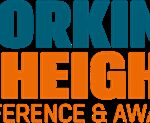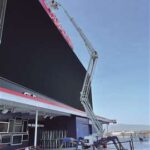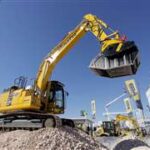When it comes to construction, safety and efficiency are key, especially when working at heights. That’s where manlifts come in! These machines are designed to give workers a safer and more efficient way to reach elevated workspaces. Whether you’re building, maintaining, or repairing, manlifts ensure that tasks are completed with ease while keeping everyone secure.
In this guide, we’ll dive into the types of manlifts commonly used in construction, what they do, and how to choose the best one for your project. Let’s get started!
What Are Construction Manlifts?
Simply put, construction manlifts are machines designed to give workers access to hard-to-reach areas at various heights. These lifts are a must-have on construction sites because they replace ladders, scaffolding, and other manual methods of reaching elevated spaces.
Manlifts are designed to transport both workers and materials safely and efficiently, and they’re often seen as a safer option compared to traditional climbing methods. With the right manlift, your crew can get the job done faster while minimizing the risk of accidents.
Types of Manlifts Used in Construction
Not all manlifts are created equal—different jobs require different types of lifts. Here’s a rundown of the most common manlifts used in construction:
-
Self-Propelled Manlifts
Small but mighty, these lifts are ideal for one person and can be used for jobs that require simple elevation. They are compact, easy to maneuver, and great for tight spaces. For example, the Genie AWP-20s can reach up to 26 feet, making it perfect for smaller jobs like routine maintenance. -
Push-Around Manlifts
Slightly larger than self-propelled manlifts, these machines can elevate workers to heights of 15-50 feet. They’re designed with retractable legs to provide a stable base at higher elevations, ensuring safety while you work. The Genie AWP-30s, for example, can reach up to 35 feet and is perfect for general construction tasks. -
Atrium (Belt) Manlifts
These are compact and heavy-duty lifts designed for tough outdoor conditions. With retractable legs and tank-like tracks, they can handle uneven surfaces like mud or dirt. They’re perfect for reaching heights of up to 34 feet, even when dealing with obstacles like trees or power lines. -
Scissor Lifts
Known for their stability, scissor lifts are typically used for vertical elevation. They’re perfect for indoor and outdoor projects, especially when carrying both personnel and tools. The Genie GS-2669 DC is a great example, offering rough terrain capabilities and providing a reliable solution for maintenance and repairs. -
Boom Lifts
For high-reaching tasks in outdoor environments, boom lifts are the go-to option. These lifts have telescopic or articulated arms that allow for both vertical and horizontal movement, making them perfect for navigating around powerlines or trees. The Genie ZX-135/70 is an excellent model, capable of reaching up to 141 feet with a 360-degree rotating turntable.
Each of these manlifts has its own strengths and is suited for different types of jobs. Knowing which one fits your needs will help you choose the right tool for the task.
How to Choose the Right Manlift for Your Construction Projects
Choosing the right manlift is crucial for ensuring the success of your project. Here are some factors to consider when making your decision:
-
Height Requirements
Make sure the manlift can reach the height you need. It’s essential to accurately estimate the elevation of the area before choosing your lift. -
Weight Capacity
Each manlift has a weight limit, so it’s important to consider the amount of weight—workers and materials—the lift needs to support. Choosing a lift with the right weight capacity ensures safe and efficient work. -
Indoor vs. Outdoor Use
Some lifts are better suited for indoor use (e.g., scissor lifts), while others, like boom lifts, are designed for outdoor environments. Consider the type of worksite and whether the lift will be used indoors or outdoors. -
Power Source
Manlifts are powered by either electricity or diesel fuel. Electric-powered manlifts are quieter and ideal for indoor tasks, while diesel-powered manlifts provide more torque and are better for outdoor projects. -
Terrain
Take the work environment into account. If your worksite has uneven terrain or inclines, you’ll need a lift with stabilizers or all-terrain capabilities to maintain balance and prevent accidents. -
Safety Features
Ensure that the manlift has safety features such as guardrails, harnesses, and emergency controls. Proper training and PPE (personal protective equipment) are essential to protect your workers while using these lifts.
Partnering with Hastings Motor
At Hastings Motor, we understand that choosing the right manlift can make or break your project. That’s why we offer a variety of manlifts to meet the unique needs of your construction tasks. Whether you need to buy or rent, we’ve got you covered with top-quality equipment and excellent customer service.
Not sure whether to buy or rent? Our rental services offer a cost-effective solution, so you can get the right equipment without the long-term commitment.
Visit our website or contact us to learn more about how we can help make your construction projects safer and more efficient. Let’s elevate your work!




